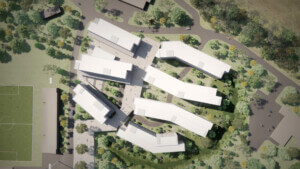Manhattan’s far west side is about to become one of the busiest construction sites in the country. Last Tuesday morning, officials gathered at the corner of 9th Avenue and West 33rd Street to celebrate the second major groundbreaking in the Hudson Yards District, Brookfield Properties’ trio of new SOM-designed towers comprising the Manhattan West development to be built over a large rail yard serving Penn Station. The $4.5 billion project’s first phase, construction of the north portion of the railroad-spanning platform that will eventually support development, is now underway, and New York Mayor Michael Bloomberg speculated that the second half of the platform could be underway in coming months. Excavation has been ongoing since the fall of 2012.
“From Battery Park to Riverside Park, it’s just amazing how much development there has been all along the west side; an area everybody thought did not have the potential to become a hot neighborhood.” Bloomberg said. “Manhattan West will be a prime location in which to live or work, a vital piece of the mixed-use community we’ve envisioned for the Hudson Yards area, which is beginning to take shape.” He noted the project’s proximity to Hudson River Park, the High Line and its cultural connections in Chelsea, and ease of access via Penn Station. Bloomberg was joined on stage by Manhattan Borough President Scott Stringer, Port Authority’s Patrick Foye, Hudson Yards Development Corporation President Ann Weisbrod, Brookfield chairman John Zuccotti, and Brookfield executives Dennis Friedrich and Ric Clark.
Bloomberg attributed the success of the west side to a 2005 rezoning of the Hudson Yards district and the 7-line subway extension. “Let me remind you,” he noted. “A subway line paid for by city dollars when the state wouldn’t come through.” He said over $6 billion has been invested in the area since 2005. Brookfield has owned the Manhattan West site since 1984, and Friedrich noted that the current economic conditions made it the right time to build.
Twin office towers with retail space will anchor the corners of the site, each with two million square feet of office space, and a third residential building will be built along West 31st Street for a total of 5.4 million square feet of space. The cores of the office towers will be anchored in bedrock adjacent to the new platform and the residential tower will be built to the side of the rail yards, adjacent to the new platform.
In addition to the three towers, Manhattan West also calls for a 100-foot-wide swatch of new public space between the office towers built on the new platform. High Line designers James Corner Field Operations will design the new 1.5-acre landscape, which is imagined as a recreated 32nd Street forming a pedestrian link with Hudson Yards and park amenities farther west. “The open space at the center of the development will form a pedestrian-friendly link between those mass-transit hubs and Hudson Yards, the High Line, and the Hudson River Park,” Bloomberg said.
The existing 16-story tower built in 1970 and already spanning the yards is also being redeveloped, and the Observer reports that Brooklyn-based firm REX will be handling the updates to the building, which, based on new renderings from Brookfield, includes a new facade. The structure was originally designed by Davis, Brody & Associates.
Initial work includes building the northern platform over the west side rail yards, work that is expected to be complete by late 2014. Friedrich said office construction will start thereafter once financing is secured, remaining optimistic that initial tenants could be on site in the first tower by 2016. Financing for the $680 million deck is already in place with a $340 million construction loan. Brookfield is paying for the remaining $340 million.
The deck consists of 16 prefabricated concrete bridge structures covering 60 percent of the five-acre Manhattan West site. “Initially we planned a platform that involved a very elaborate system of structural steel down at the track level,” Friedrich said. “We challenged our engineering teams and they came up with a new plan called a ‘segmental precast bridge system,'” that minimizes the disruption to track levels, reduces costs, and speeds up construction time. A sample segment of the platform was on display, which Mayor Bloomberg and spectators signed after the ceremony. The large “launcher” that will set the platform pieces in place (see video above) is currently being fabricated off site.










